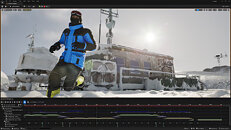Unreal Engine 5.4 is here, and it's packed with new features and improvements to performance, visual fidelity, and productivity that will benefit game developers and creators across industries. With this release, we're delivering the toolsets we've been using internally to build and ship Fortnite Chapter 5, Rocket Racing, Fortnite Festival, and LEGO Fortnite. Here are some of the highlights.
Animation
Character rigging and animation authoring
This release sees substantial updates to Unreal Engine's built-in animation toolset, enabling you to quickly, easily, and enjoyably rig characters and author animation directly in engine, without the frustrating and time-consuming need to round trip to external applications. With an Experimental new Modular Control Rig feature, you can build animation rigs from understandable modular parts instead of complex granular graphs, while Automatic Retargeting makes it easier to get great results when reusing bipedal character animations. There are also extensions to the Skeletal Editor and a suite of new deformer functions to make the Deformer Graph more accessible.




On the animation authoring front, we've focused on making our tools both more intuitive and more robust, as well as streamlining workflows. This includes Experimental new Gizmos; reorganized Anim Details; upgrades and improvements to the Constraints system; and a new Layered Control Rigs feature that drastically simplifies adding animation on top of anim clips.
Meanwhile, Sequencer—Unreal Engine's nonlinear animation editor—gets a significant makeover, with better readability and improved usability in several aspects of the Sequencer Tree. Among other new features in this release, we've also added Keyframe Scriptability, which opens up further potential for the creation of custom animation tools.
Animation gameplay
Motion Matching, previously introduced as an Experimental feature, is now Production-Ready: in fact, it's been battle-tested in Fortnite Battle Royale and shipped on all platforms from mobile to console, running on all 100 characters plus NPCs.
Motion Matching is an expandable next-gen framework for animation features. Instead of using complex logic to select and transition animation clips at runtime, it relies on searching a relatively large database of captured animation using the current motion information of the character in game as the key.
In this release, we've focused on making this animator-friendly toolset robust, performant, and memory-scalable, as well as adding a suite of debugging tools that give developers visibility to its inner workings.
Also on the gameplay front, we've added Choosers, a much-requested tool that enables you to use game context to drive animation selection. The system can both use variables to inform selections and set variables based on those selections to inform back to gameplay logic.
Rendering
Nanite
Nanite—UE5's virtualized micropolygon geometry system—continues to receive enhancements, starting with an Experimental new Tessellation feature that enables fine details such as cracks and bumps to be added at render time, without altering the original mesh.
Moreover, the addition of software variable rate shading (VRS) via Nanite compute materials brings substantial performance gains. There's also support for spline mesh workflows—great for creating roads on landscapes, for example. In addition, a new option to disable UV interpolation enables vertex animated textures to be used for World Position Offset animation; effectively, this means that the AnimToTexture plugin now works with Nanite geometry.
Temporal Super Resolution
In this release, Temporal Super Resolution (TSR) has received stability and performance enhancements to ensure a predictable output regardless of the target platform; this includes reduced ghosting thanks to new history resurrection heuristics and the ability to flag materials that use pixel animation.
In addition, we've added new visualization modes that make it easier to fine-tune and debug TSR's behavior, together with a number of new options in the Scalability settings to control it with respect to target performance.
Rendering performance
With many developers targeting 60 Hz experiences, we've invested significant effort into improving rendering performance in UE 5.4; this includes refactoring the systems to enable a greater degree of parallelization, as well as adding GPU instance culling to hardware ray tracing, which also now benefits from additional primitive types and an optimized Path Tracer. Further optimizations have been made to shader compilation, resulting in a notable improvement in project cook times.
Movie Render Graph
For those creating linear content, Unreal Engine 5.4 introduces a major update to Movie Render Queue as an Experimental feature. Dubbed Movie Render Graph (MRG), the new node-based architecture enables users to set up graphs to render a single shot, or design them to scale out across complex multi-shot workflows for large teams of artists. Graphs are pipeline-friendly, with Python hooks for studios to build tools and automations.
MRG includes Render Layers, a long-requested feature that offers the ability to easily generate high-quality elements for post compositing—such as separating foreground and background elements—with support for both the Path Tracer and the Deferred Renderer.
AI and machine learning
Neural Network Engine
In Unreal Engine 5.4, the Neural Network Engine (NNE) moves from Experimental to Beta status. With support for both in-editor and runtime applications, NNE enables developers to load and efficiently run their pre-trained neural network models.
Example use cases include tooling, animation, rendering, and physics, each with different needs in terms of platform and model support. NNE addresses these disparate needs by providing a common API, enabling easy swapping of backends as required. We've also provided extensibility hooks to enable third-party developers to implement the NNE interface in a plugin.
Developer iteration
Cloud and local Derived Data Cache
New in this release, Unreal Cloud DDC is a self-hosted cloud storage system for Unreal Engine Derived Data Cache (DDC). Designed for distributed users and teams, it enables them to efficiently share Unreal Engine cached data across public network connections.
View at TechPowerUp Main Site | Source
Animation
Character rigging and animation authoring
This release sees substantial updates to Unreal Engine's built-in animation toolset, enabling you to quickly, easily, and enjoyably rig characters and author animation directly in engine, without the frustrating and time-consuming need to round trip to external applications. With an Experimental new Modular Control Rig feature, you can build animation rigs from understandable modular parts instead of complex granular graphs, while Automatic Retargeting makes it easier to get great results when reusing bipedal character animations. There are also extensions to the Skeletal Editor and a suite of new deformer functions to make the Deformer Graph more accessible.




On the animation authoring front, we've focused on making our tools both more intuitive and more robust, as well as streamlining workflows. This includes Experimental new Gizmos; reorganized Anim Details; upgrades and improvements to the Constraints system; and a new Layered Control Rigs feature that drastically simplifies adding animation on top of anim clips.
Meanwhile, Sequencer—Unreal Engine's nonlinear animation editor—gets a significant makeover, with better readability and improved usability in several aspects of the Sequencer Tree. Among other new features in this release, we've also added Keyframe Scriptability, which opens up further potential for the creation of custom animation tools.
Animation gameplay
Motion Matching, previously introduced as an Experimental feature, is now Production-Ready: in fact, it's been battle-tested in Fortnite Battle Royale and shipped on all platforms from mobile to console, running on all 100 characters plus NPCs.
Motion Matching is an expandable next-gen framework for animation features. Instead of using complex logic to select and transition animation clips at runtime, it relies on searching a relatively large database of captured animation using the current motion information of the character in game as the key.
In this release, we've focused on making this animator-friendly toolset robust, performant, and memory-scalable, as well as adding a suite of debugging tools that give developers visibility to its inner workings.
Also on the gameplay front, we've added Choosers, a much-requested tool that enables you to use game context to drive animation selection. The system can both use variables to inform selections and set variables based on those selections to inform back to gameplay logic.
Rendering
Nanite
Nanite—UE5's virtualized micropolygon geometry system—continues to receive enhancements, starting with an Experimental new Tessellation feature that enables fine details such as cracks and bumps to be added at render time, without altering the original mesh.
Moreover, the addition of software variable rate shading (VRS) via Nanite compute materials brings substantial performance gains. There's also support for spline mesh workflows—great for creating roads on landscapes, for example. In addition, a new option to disable UV interpolation enables vertex animated textures to be used for World Position Offset animation; effectively, this means that the AnimToTexture plugin now works with Nanite geometry.
Temporal Super Resolution
In this release, Temporal Super Resolution (TSR) has received stability and performance enhancements to ensure a predictable output regardless of the target platform; this includes reduced ghosting thanks to new history resurrection heuristics and the ability to flag materials that use pixel animation.
In addition, we've added new visualization modes that make it easier to fine-tune and debug TSR's behavior, together with a number of new options in the Scalability settings to control it with respect to target performance.
Rendering performance
With many developers targeting 60 Hz experiences, we've invested significant effort into improving rendering performance in UE 5.4; this includes refactoring the systems to enable a greater degree of parallelization, as well as adding GPU instance culling to hardware ray tracing, which also now benefits from additional primitive types and an optimized Path Tracer. Further optimizations have been made to shader compilation, resulting in a notable improvement in project cook times.
Movie Render Graph
For those creating linear content, Unreal Engine 5.4 introduces a major update to Movie Render Queue as an Experimental feature. Dubbed Movie Render Graph (MRG), the new node-based architecture enables users to set up graphs to render a single shot, or design them to scale out across complex multi-shot workflows for large teams of artists. Graphs are pipeline-friendly, with Python hooks for studios to build tools and automations.
MRG includes Render Layers, a long-requested feature that offers the ability to easily generate high-quality elements for post compositing—such as separating foreground and background elements—with support for both the Path Tracer and the Deferred Renderer.
AI and machine learning
Neural Network Engine
In Unreal Engine 5.4, the Neural Network Engine (NNE) moves from Experimental to Beta status. With support for both in-editor and runtime applications, NNE enables developers to load and efficiently run their pre-trained neural network models.
Example use cases include tooling, animation, rendering, and physics, each with different needs in terms of platform and model support. NNE addresses these disparate needs by providing a common API, enabling easy swapping of backends as required. We've also provided extensibility hooks to enable third-party developers to implement the NNE interface in a plugin.
Developer iteration
Cloud and local Derived Data Cache
New in this release, Unreal Cloud DDC is a self-hosted cloud storage system for Unreal Engine Derived Data Cache (DDC). Designed for distributed users and teams, it enables them to efficiently share Unreal Engine cached data across public network connections.
View at TechPowerUp Main Site | Source





